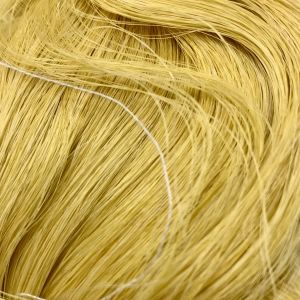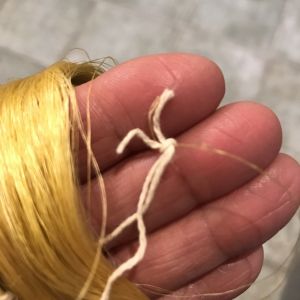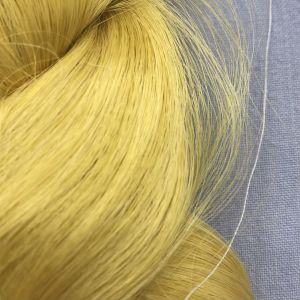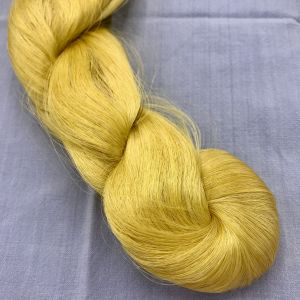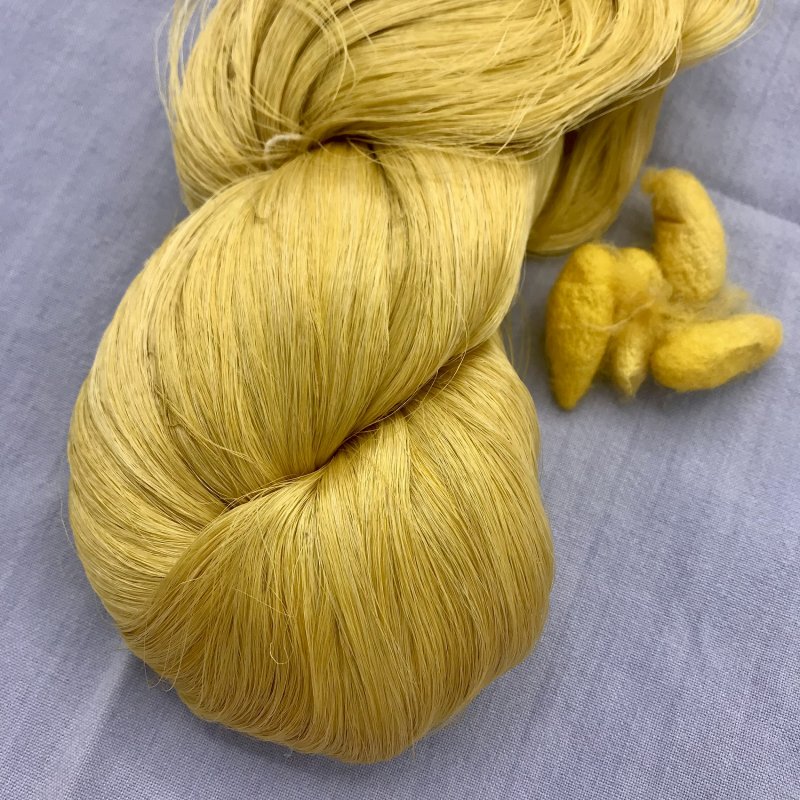
Photo above: Naturally yellow Reeled Nistari Bombyx 3-ply silk beside Nastari cocoons.
A few months ago we introduced, from India, naturally yellow Nistari Bombyx as combed top/sliver for spinning. We now have REELED Nistari in two sizes!
ABOUT NATURALLY YELLOW NISTARI
Yellow bombyx mori cocoons are found in SE Asia, Bengal and India. Our yellow bombyx silk is from India, produced in the general region as Muga and Eri silks. The locals call it "Nistari".
Nistari is a different race than its white bombyx mori counterpart. The yellow color is NOT caused by the food it eats--Nistari silk worms eat mulberry leaves, just like the white bombyx mori silk worm.
The cocoons are an amazingly intense golden yellow (see photo above). The yellow color is somewhat fugitive. You can see the reeled silk isn't as deep a yellow as the cocoons. Some color disappears during reeling. To keep as much of the yellow color, use cold water only, although it may still lighten a bit with each washing.
DO NOT use warm or hot water and NO hydrogen peroxide (in the soap or anything that has been bleached/whitened in the same wash basin), as this will definitely remove more of the natural yellow color.
REELED NISTARI SILK
We purchased two sizes of Nistari silk...singles and 3-ply. Our reeled Nistari Bombyx is super-super thin
REELED SINGLES (the skinnier of the two)
"Singles" means it is not plied. [see Photo #5 below]
The Nistari Bombyx-Singles is about 28-30 denier. How thin is is that? My eye-ball comparison is it is thinner than a strand of my hair.
See Photo #4 [below] for a close up of Nistari Singles compared to Arabella's Web (120/2 spun silk). If you're not familiar with the size of 120/2 size silk, it's a bit thinner than your typical sewing machine thread. You can see that Reeled Nistari Singles is definitely thinner than Arabella's Web.
This silk is perfect for weavers who like 240/2 silk or finer. CLICK HERE to order Reeled Nistari Singles.
REELED 3-PLY (the thicker of the two..."thick" being a relative term)
Three of the Reeled Singles are plied together to make this 3-Ply silk. This is about 85 denier. That may sound like a lot, but the 3-ply is still a bit thinner than a strand of my hair.
Photo #2 (below) shows a close-up of the Reeled Nistari 3-ply along with a white strand of Arabella's Web (120/2 spun silk). As you can see in the photo, the 3-Ply is a bit thinner than Arabella's Web.
This silk is perfect for weavers who like 120/2 silk or finer. CLICK HERE to order Reeled Nistari 3-ply
ABOUT ORDERING
The skeins vary in weight. I have weighed half of the skeins and they range between 55-80 grams. When you order, please indicate if you prefer a bigger or a smaller skein (the price shown is for a 80g skein).
Once your skein is pulled and weighed, we will adjust your price and then process your credit card. We will call you if we have any questions.
HANDLING THE SKEIN
First, make sure your hands are smooth--I thought I was in good shape, but a strand of reeled silk grabbed onto an invisible rough spot on my cuticle. Once disentangled, I used our hand-crafted lotion bar--I love this--and all was good going forward.
There are three skein ties. If you inspect carefully, you'll find the ends tied to one of the skein ties (see photo #3 below).
As with all silk, we recommend having your swift attached at 90 degrees from "normal", so the swift spins like a Ferris wheel (NOT around like a merry go round)
We have both wooden and wire swifts. The wire swifts are lighter weight, requiring less tension to turn. Because the Nistari reeled silk is so very fine, I opted to use the metal swift.
***note about my experience with my metal swift: My metal swift has vinyl covering the parts of the swift that presses against the yarn, so it is wonderfully smooth. But when I was ready to remove the silk and I collapsed the swift, the silk snagged on the metal "joints" of the swift. This is because the strands of silk are so skinny and light weight, they can end up where thicker yarn would never touch. I solved this issue by putting a smooth cloth between the swift and the skein. The cloth doesn't have to go all the way around--just lay the cloth over the top of the swift, set your skein onto your swift and then expand the swift. When ready to collapse your swift to remove the silk, just rotate the swift until the cloth is at the top again, and then collapse your swift.
I've not had time to actually wind the Reeled Nistari from the swift onto a bobbin. The silk skein has some "waves" in it that get smoother with allowing it to rest.
So, just like I did with our Reeled Muga Silk, I positioned the skein on the swift and gently opened it far enough to expand the skein but without putting much pressure on the skein. After resting just 15 minutes, I could tell this was going to make the silk happier. I opened the swift a bit more, to put a bit of tension on the silk. I plan to let it rest for 24 hours.
After that? I'll try hand-winding it directly from the swift onto a bobbin, so it's ready to use after I've dreamed up a fine-threads project. Silk is strong, but this is super fine (compared to what I'm used to) so I'll proceed slowly and carefully.


